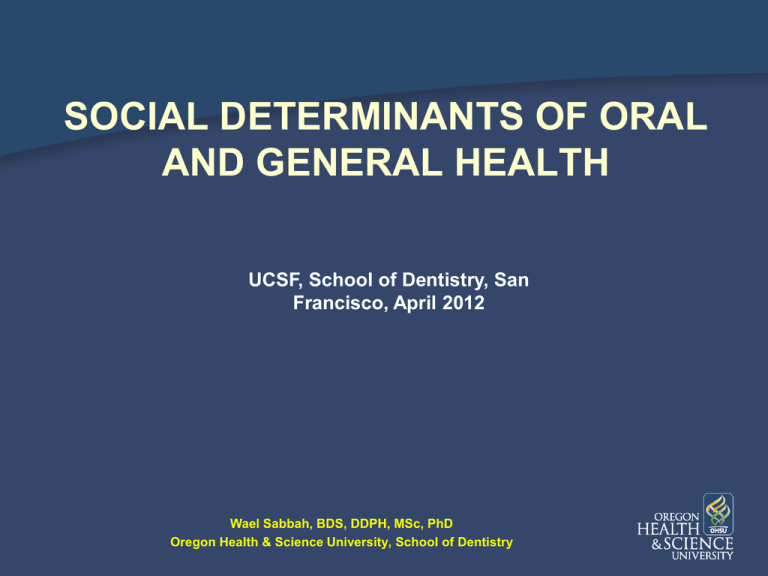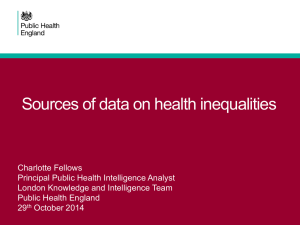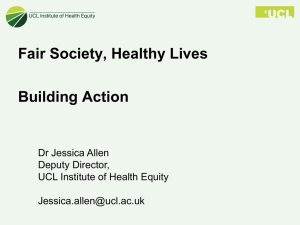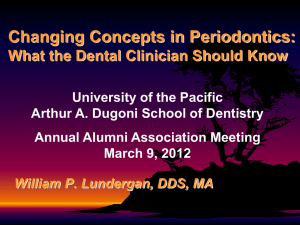
SOCIAL DETERMINANTS OF ORAL
AND GENERAL HEALTH
UCSF, School of Dentistry, San
Francisco, April 2012
Wael Sabbah, BDS, DDPH, MSc, PhD
Oregon Health & Science University, School of Dentistry
Outlines
• Oral health and general health: the common risk factors.
• The social determinants: evidence and characteristics
(social gradient).
• Pathways for health inequalities: can we explain the
social gradient?
• Can behavioral factors account for inequalities?
• The role of psychosocial factors?
• Contribution of health services
• Strategies and policies to address health inequalities.
2
Public health is a social issue.
“Interventions aimed at reducing disease
and saving lives succeed only when they
take the social determinants of health
adequately into account.” (Lancet, 2005)
Dr Lee Jong-Wook
(Director General, WHO)
3
“…oral health and general health
should not be interpreted as separate
entities”
Surgeon General’s Report on Oral Health of
America, 2000
4
• Direct links between oral health and general
health:
1. Specific systemic conditions affect oral health
2. Oral conditions affect general health
(inflammatory, nutritional pathways).
Or co-morbidity
5
• General susceptibility: Linked to the
commonality of the social determinants.
• There are common, rather than specific,
risk factors that affect a wide range of
chronic conditions, including oral health.
6
Common Risk Factor
Obesity
Diet
Diabetes
Tobacco
Cancers
Cardiovascular diseases
Alcohol
Dental caries
Periodontal diseases
Hygiene
Skin diseases
Sheiham and Watt 2000
7
The Determinants of the Common
Risk Factors
• ‘Smoking, obesity and heavy drinking are
causes of ill-health, but what are the
causes of these behaviors?’ WHO CSDH, Fair
Society, Healthy Lives, Marmot (2010).
• Choices pertaining to health-related
behaviors are situated within economic,
historical, family, cultural and political
contexts.
8
The Determinants of the Common
Risk Factors
• Individual behaviors such as smoking,
diet, alcohol, physical activities, general
and oral hygiene, attendance for medical
and dental screening and care are largely
influenced by the social environments and
conditions in which people live and their
status.
9
The causes of the causes
Distal risk
factors
Socioenvironmental
conditions
Economics
Employment
Status
Proximal modifiable
risk factors
Tobacco
Diet
Alcohol
Hygiene
Stress
Sex
Geoffrey Rose
10
Outcome
Chronic
diseases
The Determinants of the Common
Risk Factors
• Proximal risk factors explain a relatively
small portion of the variance in
socioeconomic differences in health, thus
highlighting
the
importance
of
psychosocial, economic, political and
environmental factors to health and
disease. These factors are known as the
social determinants of health.
11
Common Risk Factor Approach: Including Societal Risk
Risk Factors
Diet
Diseases
Obesity
Risk Factors
Tobacco
Cancers
Workplace
School
Stress
Heart disease
Alcohol
Respiratory disease
Control
Policy
Exercise
Periodontal diseases
Hygiene
12
Dental caries
Political
environment
Trauma
Physical
environment
Housing
Injuries
Social
environment
Socioeconomic inequalities in health
Rates of morbidity and mortality are
successively lower at successively
higher rungs on the social ladder.
Those in the higher ranks are healthier
than those immediately below them.
This phenomenon is also known as
the social gradients.
Marmot , Wilkinson , 2006.
13
Life expectancy by social class
84
82
Life expectancy
80
78
76
74
72
Social Class I
Social Class II
Social Class IIIN Social Class IIIM Social Class IV
Social Class V
Life expectancy by social class, England and Wales 1992-1996 (Marmot 2003)
14
Self-rated health among USA adolescents
Starfield et al 2002
15
16
Life expectancy by neighbourhood
income in urban Canada, 1971-2001
Statistics Canada
17
Life expectancy differences: USA
Travel from the Southeast of downtown
Washington to Montgomery County Maryland. For
each mile travelled life expectancy rises about a
year and a half.
There is a twenty year gap between poor blacks at
one end of the journey (Male LE 57) and rich whites
at the other (LE 76.7).
Marmot , 2005.
18
Life expectancy differences in London
Male life
expectancy
69.0 (67.3-70.8)
Male life expectancy
76.2 (74.3-78.2)
Canning Town
Female life
expectancy
76.9 (75.3-78.5)
Female life expectancy
82.9 (80.5-85.3)
Westminster
Canary
Wharf
London Bridge
River Thames
Bermondsey
Canada
Water
North
Greenwich
Waterloo
Southwark
8
stations
between
Westminster
and
Canning Town on the
Jubilee
Line:
nearly1
year of shorter lifespan
per
station
(as
one
travels east)
London Underground Jubilee Line
19
Oral health inequalities
Significant
social
class
differences
– Caries
– Periodontal diseases
– Oral cancers
– Self reported oral health
status
Individual,
area
and
population level
Certain ethnic minority groups
and socially excluded groups
Close link with general health
Watt and Sheiham (1999)
20
Education gradients in perceived oral/general health,
periodontal disease, and ischemic heart disease.
4
3.5
Odds Ratio
3
2.5
Education>12 year
2
Education=12 years
Education<12years
1.5
1
0.5
0
Perceived oral
health
Sabbah et al 2007
Perceived
general health
Periodontitis
21
Ischemic heart
disease
Social gradients in oral health
22
Social Gradients in Oral Health
Many studies have shown a social gradient in oral
health
Almost all have been carried out on adults1-9
Only a couple on adolescents10-11
They have mostly used 1 or 2 socioeconomic
position markers (not always the same)
1.
2.
3.
4.
5.
6.
7.
8.
9.
10.
11.
Drury TF, Garcia I, Adesanya M (1999). Ann N Y Acad Sci; 896:322-324.
Sanders AE, Slade GD, Turrell G, John SA, Marcenes W (2006). Community Dent Oral Epidemiol; 34: 310-319.
Do LG, Roberts-Thomson KF (2007). Aust Dent J;52:249-251.
Morita I, Nakagaki H, Yoshii S et al. (2007) . Eur J Oral Sci; 115: 275-279.
Sabbah W, Tsakos G, Chandola T, Sheiham A, Watt RG (2007). J Dent Res; 86: 992-996.
Holst D (2008). Community Dent Oral Epidemiol; 36: 326-334.
Sanders AE, Slade GD, John MT et al. (2009). J Epidemiol Community Health; 63: 569-574.
Tsakos G, Sheiham A, Iliffe S et al. (2009). Eur J Oral Sci; 117: 286-292.
Finlayson TL, Williams DR, Siefert K, Jackson JS, Nowjack-Raymer R (2010). Am J Public Health; 100 (Suppl.1):S246S255.
Thomson WM, Poulton R, Milne BJ, Caspi A, Broughton JR, Ayers KM (2004). Community Dent Oral Epidemiol; 32:345353.
Lopez R, Fernandez O, Baelum V (2006). Community Dent Oral Epidemiol; 34: 184-196.
23
Loss of periodontal attachment and social class
Morris, Steele, White. 2001
24
Prevalence of oral morbidity according to relative
social status and absolute material resource
Sanders et al. 2006
25
26
Income inequality and periodontal disease
Sabbah et al 2010
27
Social determinants of health
• What are the pathways?
28
Simplified pathways between the social
determinants and oral health
Health-related
behaviors
Life course
29
Oral Health
The role of health-related behaviors
Health behaviors are social grade specific.
“Poor people behave poorly”
30
Health behaviors are socially patterned
People who are in the lower social
grades are more likely to engage in a
wide range of risk related behaviors
and less likely to be involved in health
promoting ones.
Lynch, Kaplan, Salonen Why do poor people behave poorly? Variation in adult health behaviours and
psychosocial characteristics by stages of the socio-economic life course. Soc Sci Med 1997; 44: 809-819.
31
Smoking and drinking in Scotland 2003
MacIntyre S 2008
32
Health behaviors by education
The Norwegian Institute of Public Health
33
Behavioral factors: diet
Health Survey for England, 2001
34
Probabilities of engaging in a cluster of
health compromising behaviors
1.4
1.35
1.3
1.25
1.2
1.15
1.1
1.05
1
0.95
0.9
highest
middle
lowest
highest
Education
Unpublished data (NHANES)
2nd highest
2nd lowest
Income
35
lowest
Do health behaviors “explain” health
inequalities?
Odds ratio for perceived poor oral health
2.5
US adults (NHANES III)
2
1.5
1
0.5
0
Education = 12 yrs
Education < 12 yrs
adjusted for confounders
adjusted also for behaviours
36
Sabbah, Tsakos, Sheiham, Watt (2009). Soc Sci Med; 68(2): 298-303.
Do health behaviors “explain” health
inequalities?
Count ratio of tooth surface loss
2.5
US adults (NHANES III)
2
1.5
1
0.5
0
Education = 12 yrs
Education <12 yrs
adjusted for confounders
adjusted also for behaviours
37
Sabbah, Tsakos, Sheiham, Watt (2009). Soc Sci Med; 68(2): 298-303.
Evaluating the role of dental behavior in
oral health inequalities
“To reduce social inequalities in adult oral health,
efforts need to be directed to factors other than
the dental behaviors of individuals…. Rather
than focusing on individuals alone, the approach
needs to achieve a better balance of targeting
both individual level factors and also the social
environments in which health behaviors of
individuals are developed and sustained.”
Sanders, Spencer & Slade (2006)
38
Stress and the health
• Stress induced by SEP, work and living
environment affects health.
• Stress affects health indirectly via healthrelated behaviors,
or directly through biological changes:
When the external and internal stress challenges are
chronic and frequently beyond the normal ranges of
adaptive responses, “wear and tear” on regulatory
systems occurs and allostatic load accumulates.
(McEwen, 1998)
39
Stress and the health
Stressful situation which affect general health
(cardiovascular disease) and oral health
(periodontal disease):
Work related mental demand,
lack of control at work and/or at home,
unemployment,
negative life events,
low levels of marital quality
(Marmot and Wilkinson, 2006; Seeman et al 2001; Sheiham and Nicolau, 2005).
40
Probabilities of having ischaemic heart disease and periodontal
disease by increased levels of allostatic load
3
2.5
2
1.5
1
0.5
0
Ischaemic Heart
Disease
Sabbah et al 2008
Gingival Bleeding
41
Loss of Periodontal
Attachment
Pocket Depth
Change in education gradients in ischaemic heart disease and periodontitis after
adjusting for allostasis
2.5
Odds Ratio
2
1.5
unadjusted for allostasis
adjusted for allostasis
1
0.5
0
education=12years education<12years education=12years education<12years
Ischaemic heart disease
Sabbah et al 2008
Periodontitis
42
Stress and Health-Related Behaviors
• Higher levels of biological markers of stress
were associated with higher probabilities of
engaging in a number of oral and general
health-compromising behaviors after accounting
for demographic and socioeconomic factors.
Sabbah 2011, unpublished data
43
Adjusted odds for poor health-related behaviors for an extra marker of
allostatic load
1.2
1.18
1.16
1.14
1.12
1.1
1.08
1.06
1.04
1.02
1
0.98
Less frequent exercise
Fattening food
44
Fewer fruits and vegerables
Adjusted odds ratios for poor health-related behavior for an extra
marker of allostatic load
1.24
1.22
1.2
1.18
1.16
1.14
1.12
1.1
1.08
1.06
1.04
Smoking
Less frequent dental visits
45
Oral hygiene
Health Services
Recommendations for Actions for Universal
Health Care (WHO Commission on Social Determinants of
Health, 2009).
Universal coverage of quality services,
focusing on Primary Health Care.
Tax/ insurance-based funding, ensuring
universal coverage regardless of ability to
pay
46
47
48
Population health in England and US (Banks et al
2006)
45
40
35
Percent
30
25
20
15
10
5
0
England
US
49
Universal health coverage and health disparities (USA/ Canada)
Self-rated general health (poor/fair) by
household income
35
30
percentage
25
20
Canada
15
US
10
5
Severe mobility limitation by household
income
0
Poorest
Richest
25
percentage
20
15
Canada
US
10
5
0
50
Poorest
Richest
Use of medical and dental care (USA/ Canada)
Percentage with regular medical doctor
90
80
percentage
70
60
50
40
30
20
All
Canada
Insured
Uninsured
US
Dental Visits Canada and USA
70
60
percentage
50
40
Canada
30
US
20
10
0
<1 year
51
1 to<3years
Last dental visit
3years+/ never
Exclusion of dental services from the universal health coverage
(in Canada)
% of People Reporting
1≥ Visits
Visits to Dentist and Family Physician, by Income
90
80
70
60
50
40
30
20
10
0
%visits dental
%visits physician
< 20,000
20,00049,999
• “All people visit
physicians. Young,
healthy, wealthy, well
educated people visit
dentists”.
•
>49,000
Income ($)
52
Sabbah W, Leake JL. Comparing
characteristics of Canadians who visited
dentists and physicians during 1993/94: A
secondary analysis. JCDA, 2000, 66 (2): 90
Early life course
• Biological, behavioral and social hazards
operate across the life course and
influence the development of chronic
diseases.
• Tracking the progress of general and oral
conditions through the life course.
53
Priorities for research
• Social determinants of health.
• Commonality of the social and behavioral
risk factors for oral and general health.
• Associations between oral and general
health.
54
Priorities for research
• Oral and general health of ethnic minorities
and indigenous populations.
• Inequality in the use of health services.
• Life course approach to investigate the
progress of risk factors, and tracking of
chronic conditions.
55
Upstream - downstream interventions
National &/or local policy initiatives
‘Upstream’
Healthy Public Policy
Legislation/Regulation
Fiscal Measures
Healthy Settings- HPS
Community Development
Training other professional groups
Media Campaigns
School dental
health education
Chair side dental
health education
‘Downstream’
56
Health Education &
Clinical Prevention
Clinical Prevention
Policy implications
• Incorporate research findings on the social
determinants in health promotion intervention.
• Research on oral health should be incorporated
as appropriate into policies for the integrated
prevention and treatment of acute and chronic
diseases into health policies.
• We should explore how to combine forces and
use our abilities to change environmental,
cultural, and individual factors through joint effort.
57









